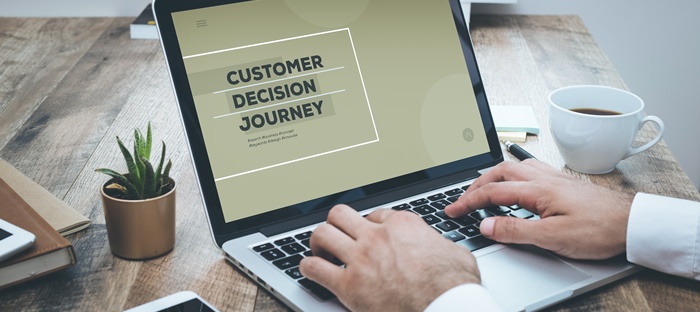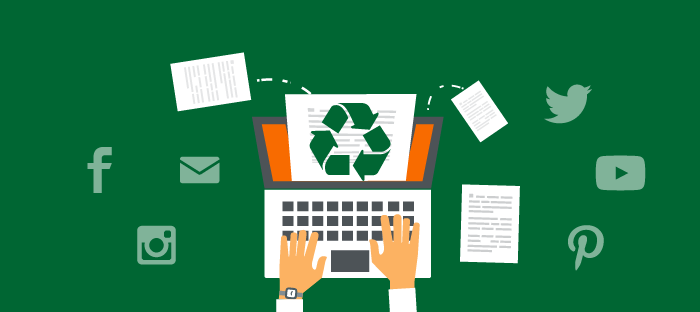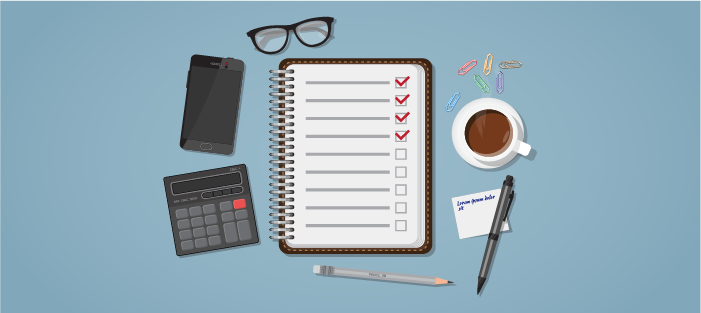Content With Purpose: How to Align Content to the Buyer’s Journey

My husband and I both bought jeans last week.
I did a ton of research online, looking to see what cut would be most flattering to my shape. Then, once I decided what style I wanted, I looked around to compare different brands. Price, user reviews, customer photos, fabric, the percentage of stretch in the fabric; these were all things I carefully considered. Once I’d decided on a specific pair, I combed the internet for sales before finally finding a sale (and a discount code!) and made my purchase.
My husband went to Amazon and ordered a pair of 32x32 Levi 501’s. The entire process took him 5 minutes.
Any woman who reads this is probably nodding her head in recognition right now. But so are many seasoned marketers.
Why? Because the stories I just shared are an example of what marketers call the buyer’s journey.
What is the buyer’s journey?
The example I gave is from the perspective of a consumer, but the overall principle applies whether you’re B2C or B2B: For many people, the shopping process starts long before they click “add to cart” or “contact us for a demo.” Moreover, that shopping process varies depending on who the customer is.
This is why we suggest every marketer should develop their own buyer personas, which are basically avatars of your ideal buyer(s), complete with semi-fictional biographies.
Related Content: The 8 Biggest Mistakes You’re Making With Your Buyer Personas
As buyer personas work to understand the problems they have and their potential options for solving those problems, they generally follow a journey that takes them through three distinct stages. Their questions (and the content they need to answer those questions) will change as they move from one stage to the next.
The three stages of the buyer’s journey
- Awareness: In the awareness stage, a buyer is experiencing a problem. These people probably haven’t heard of you yet, and they’re doing educational research to help them more clearly understand their problem.
- Consideration: During the consideration stage, a buyer knows what their problem is, and they’re researching their options to try to figure out the best solution is for their needs. During this time, a buyer will also start to compare different approaches, but they’re not yet at the point of comparing vendors.
- Decision: The decision stage is where a buyer is getting ready to make a purchase decision. They generally know what they want to buy, and now they’re comparison shopping to make sure they pick the perfect solution and vendor.
It’s interesting to note that the buying journey is not always linear. Some personas may spend a lot of time in one stage and may even bounce back and forth between stages until they get to a decision. Others might spend only a short time in the first two stages while making a beeline for the third.
Tailoring content to the buyer’s journey
Understanding how your buyer persona’s questions evolve as they complete their buying journey is only half the challenge. The other half is figuring out how to use this insight to shape your content strategy!
Creating great content around the buyer’s journey ensures you have helpful, relevant, engaging information to share with your buyers and meet their needs at every point along their journey.
As you develop your content strategy, a good place to start is by identifying the big-picture questions buyers ask during the awareness stage, and then proceed to drill down into more detailed information on specific aspects of these questions.
Here’s a closer look at what content works best for each stage and why:
Awareness-Stage Content
In this stage, a buyer isn’t ready to hear about specific solutions. In fact, pushing your product at this stage is likely to make a buyer run for the hills. Instead, this is the time to focus on the buyer’s pain points. Offer them genuine help that answers their questions and educates them about their problem.
Good awareness-stage content includes blogs, e-books, white papers, tip sheets, guides, infographics and slideshares. Think of your content at this stage as a gift for the reader, with the only call-to-action being an offer for even more helpful information.
Consideration-Stage Content
At this point in the game, the buyer knows what their problem is, and they’re starting to look at options that might solve the problem. However, they’re still not ready for an ask.
Content for this stage could include anything that shows how a particular solution would solve their problem. This content might include more technical blog posts, comparison white papers or e-books, webinars and product feature videos.
Remember, the buyer still isn’t ready to book a demo or a consultation, so create content that gently guides them to take the next step of learning more about specific solutions that you offer.
Decision-Stage Content
Finally, the lead is ready to buy, and now they’re determining who the lucky vendor will be. Content highlighting the problem is wasted at this point. Instead, the lead wants to know the details about your solution: how it works, who else uses it and what they think of it.
It’s now time to haul out the big guns with testimonials, trial offers, live product demos, vendor/product/pricing comparisons, and any other content that will give you the edge over your competitor.
You may find yourself naturally gravitating toward a particular stage of this journey, but keep in mind that a good content strategy answers questions at every stage of the buyer’s journey. And even better, a great content strategy takes buyer personas into account too, making sure there’s an abundance of content that reflects the unique journey different personas will take.
When done well, a content strategy based on the buyer’s journey will position your company as the top-of-mind resource for leads. Whether a lead is still puzzling over their problem or ready to plunk down their cash, you’ll have ensured they can rely on you for the answers they need – and you’ll have positioned yourself as the natural best outcome and the tailor-made final destination on your buyer’s personalized journey.
Want to start creating great content right out of the gate? First, you need a great plan. Jumpstart your content planning process with our Complete B2B Content Strategy Guide!





